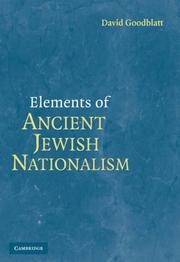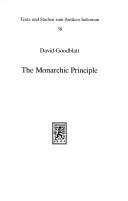| Listing 1 - 6 of 6 |
Sort by
|

ISBN: 9780511250613 0511250614 0511249047 9780511249044 0511249594 9780511249594 0521862027 1107168465 9781107168466 0511322917 9780511322914 128070361X 051125010X 051149906X 0521101670 Year: 2006 Publisher: New York : Cambridge University Press,
Abstract | Keywords | Export | Availability | Bookmark
 Loading...
Loading...Choose an application
- Reference Manager
- EndNote
- RefWorks (Direct export to RefWorks)
Contrary to the widespread view that nationalism is a modern phenomenon, Goodblatt argues that it can be found in the ancient world. He argues that concepts of nationalism compatible with contemporary social scientific theories can be documented in the ancient sources from the Mediterranean Rim by the middle of the last millennium BCE. In particular, the collective identity asserted by the Jews in antiquity fits contemporary definitions of nationalism. After the theoretical discussion in the opening chapter, the author examines several factors constitutive of ancient Jewish nationalism. He shows how this identity was socially constructed by such means as the mass dissemination of biblical literature, retention of the Hebrew language, and through the priestly caste. The author also discusses each of the names used to express Jewish national identity: Israel, Judah and Zion.
Jews --- Jewish nationalism. --- Judaism --- Hellenistic Judaism --- Judaism, Hellenistic --- Nationalism --- History --- Politics and government. --- Kings and rulers. --- Palestine --- Holy Land --- Arts and Humanities --- Religion --- Politics and government

ISBN: 3161461762 9783161461767 Year: 1994 Publisher: Tübingen: Mohr,
Abstract | Keywords | Export | Availability | Bookmark
 Loading...
Loading...Choose an application
- Reference Manager
- EndNote
- RefWorks (Direct export to RefWorks)
Exilarchate. --- Jews --- Monarchy --- Nasi. --- Palestine --- History --- Kings and rulers. --- Politics and government. --- Nasi --- Exilarchate
Book
ISBN: 9004668381 Year: 1975 Publisher: Leiden : Brill,
Abstract | Keywords | Export | Availability | Bookmark
 Loading...
Loading...Choose an application
- Reference Manager
- EndNote
- RefWorks (Direct export to RefWorks)
Book
Year: 1975 Publisher: Leiden Brill
Abstract | Keywords | Export | Availability | Bookmark
 Loading...
Loading...Choose an application
- Reference Manager
- EndNote
- RefWorks (Direct export to RefWorks)
Article
Abstract | Keywords | Export | Availability | Bookmark
 Loading...
Loading...Choose an application
- Reference Manager
- EndNote
- RefWorks (Direct export to RefWorks)

ISSN: 01699962 ISBN: 1280465492 9786610465491 1417590904 9047400747 9781417590902 9004120076 9789004120075 9789047400745 Year: 2001 Volume: 37 Publisher: Boston : Brill,
Abstract | Keywords | Export | Availability | Bookmark
 Loading...
Loading...Choose an application
- Reference Manager
- EndNote
- RefWorks (Direct export to RefWorks)
The papers published in this volume were presented at the Fourth Orion International Symposium (Jerusalem, 1999), whose focus was Jewish history in light of the Dead Sea Scrolls. The first section, “History of the Jews and Judaism,” is devoted to specific topics in Jewish history, such as historical references in the Scrolls, comparative studies between the Scrolls and Josephus, and issues of Jewish nationalism. The second section, “Community and Covenant,” comprises studies of community, Jewish law, and the concept of covenant. The third section, “Natural Sciences and the Scrolls,” reports on examinations of DNA preserved in leather used for the Scrolls, of dust found in jars from Qumran, of the nature of the stitching of the Scrolls, and of the composition of the pottery found at Qumran.
Jews --- Judaism --- Hebrews --- Israelites --- Jewish people --- Jewry --- Judaic people --- Judaists --- Ethnology --- Religious adherents --- Semites --- History --- 229*319 --- Qumran en het jodendom --- Dead Sea scrolls --- Jerusalem scrolls --- ʻAin Fashka scrolls --- Jericho scrolls --- Scrolls, Dead Sea --- Qumrân scrolls --- Rękopisy z Qumran --- Shikai bunsho --- Megilot Midbar Yehudah --- Dodezee-rollen --- Kumránské rukopisy --- Documentos de Qumrán --- Textos de Qumrán --- Rollos del Mar Muerto --- Manuscritos del Mar Muerto --- Manuscrits de la mer Morte --- Dödahavsrullarna --- Kumranin kirjoitukset --- Kuolleenmeren kirjoitukset --- Qumranhandskrifterna --- Qumranin kirjoitukset --- Qumran Caves scrolls --- 229*319 Qumran en het jodendom --- Dead Sea Scrolls --- Congresses --- 168 B.C.-135 A.D. --- Post-exilic period, 586 B.C.-210 A.D. --- Jews - History - 168 B.C.-135 A.D. - Congresses. --- Judaism - History - Post-exilic period, 586 B.C.-210 A.D. - Congresses.
| Listing 1 - 6 of 6 |
Sort by
|

 Search
Search Feedback
Feedback About UniCat
About UniCat  Help
Help News
News